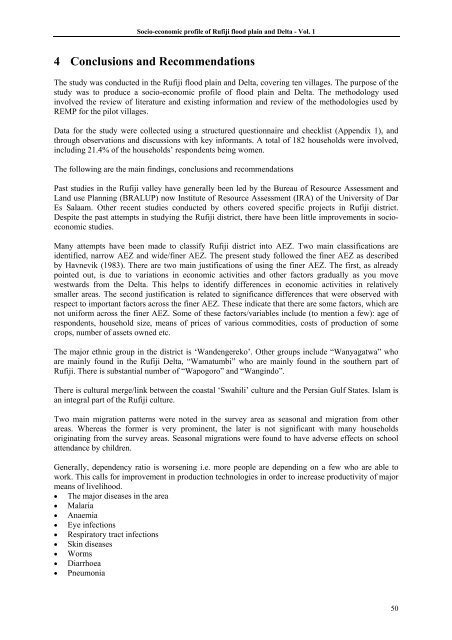A Socio-Economic Profile of the Rufiji Floodplain and Delta.
A Socio-Economic Profile of the Rufiji Floodplain and Delta.
A Socio-Economic Profile of the Rufiji Floodplain and Delta.
You also want an ePaper? Increase the reach of your titles
YUMPU automatically turns print PDFs into web optimized ePapers that Google loves.
<strong>Socio</strong>-economic pr<strong>of</strong>ile <strong>of</strong> <strong>Rufiji</strong> flood plain <strong>and</strong> <strong>Delta</strong> - Vol. 1<br />
4 Conclusions <strong>and</strong> Recommendations<br />
The study was conducted in <strong>the</strong> <strong>Rufiji</strong> flood plain <strong>and</strong> <strong>Delta</strong>, covering ten villages. The purpose <strong>of</strong> <strong>the</strong><br />
study was to produce a socio-economic pr<strong>of</strong>ile <strong>of</strong> flood plain <strong>and</strong> <strong>Delta</strong>. The methodology used<br />
involved <strong>the</strong> review <strong>of</strong> literature <strong>and</strong> existing information <strong>and</strong> review <strong>of</strong> <strong>the</strong> methodologies used by<br />
REMP for <strong>the</strong> pilot villages.<br />
Data for <strong>the</strong> study were collected using a structured questionnaire <strong>and</strong> checklist (Appendix 1), <strong>and</strong><br />
through observations <strong>and</strong> discussions with key informants. A total <strong>of</strong> 182 households were involved,<br />
including 21.4% <strong>of</strong> <strong>the</strong> households’ respondents being women.<br />
The following are <strong>the</strong> main findings, conclusions <strong>and</strong> recommendations<br />
Past studies in <strong>the</strong> <strong>Rufiji</strong> valley have generally been led by <strong>the</strong> Bureau <strong>of</strong> Resource Assessment <strong>and</strong><br />
L<strong>and</strong> use Planning (BRALUP) now Institute <strong>of</strong> Resource Assessment (IRA) <strong>of</strong> <strong>the</strong> University <strong>of</strong> Dar<br />
Es Salaam. O<strong>the</strong>r recent studies conducted by o<strong>the</strong>rs covered specific projects in <strong>Rufiji</strong> district.<br />
Despite <strong>the</strong> past attempts in studying <strong>the</strong> <strong>Rufiji</strong> district, <strong>the</strong>re have been little improvements in socioeconomic<br />
studies.<br />
Many attempts have been made to classify <strong>Rufiji</strong> district into AEZ. Two main classifications are<br />
identified, narrow AEZ <strong>and</strong> wide/finer AEZ. The present study followed <strong>the</strong> finer AEZ as described<br />
by Havnevik (1983). There are two main justifications <strong>of</strong> using <strong>the</strong> finer AEZ. The first, as already<br />
pointed out, is due to variations in economic activities <strong>and</strong> o<strong>the</strong>r factors gradually as you move<br />
westwards from <strong>the</strong> <strong>Delta</strong>. This helps to identify differences in economic activities in relatively<br />
smaller areas. The second justification is related to significance differences that were observed with<br />
respect to important factors across <strong>the</strong> finer AEZ. These indicate that <strong>the</strong>re are some factors, which are<br />
not uniform across <strong>the</strong> finer AEZ. Some <strong>of</strong> <strong>the</strong>se factors/variables include (to mention a few): age <strong>of</strong><br />
respondents, household size, means <strong>of</strong> prices <strong>of</strong> various commodities, costs <strong>of</strong> production <strong>of</strong> some<br />
crops, number <strong>of</strong> assets owned etc.<br />
The major ethnic group in <strong>the</strong> district is ‘W<strong>and</strong>engereko’. O<strong>the</strong>r groups include “Wanyagatwa” who<br />
are mainly found in <strong>the</strong> <strong>Rufiji</strong> <strong>Delta</strong>, “Wamatumbi” who are mainly found in <strong>the</strong> sou<strong>the</strong>rn part <strong>of</strong><br />
<strong>Rufiji</strong>. There is substantial number <strong>of</strong> “Wapogoro” <strong>and</strong> “Wangindo”.<br />
There is cultural merge/link between <strong>the</strong> coastal ‘Swahili’ culture <strong>and</strong> <strong>the</strong> Persian Gulf States. Islam is<br />
an integral part <strong>of</strong> <strong>the</strong> <strong>Rufiji</strong> culture.<br />
Two main migration patterns were noted in <strong>the</strong> survey area as seasonal <strong>and</strong> migration from o<strong>the</strong>r<br />
areas. Whereas <strong>the</strong> former is very prominent, <strong>the</strong> later is not significant with many households<br />
originating from <strong>the</strong> survey areas. Seasonal migrations were found to have adverse effects on school<br />
attendance by children.<br />
Generally, dependency ratio is worsening i.e. more people are depending on a few who are able to<br />
work. This calls for improvement in production technologies in order to increase productivity <strong>of</strong> major<br />
means <strong>of</strong> livelihood.<br />
• The major diseases in <strong>the</strong> area<br />
• Malaria<br />
• Anaemia<br />
• Eye infections<br />
• Respiratory tract infections<br />
• Skin diseases<br />
• Worms<br />
• Diarrhoea<br />
• Pneumonia<br />
50
















